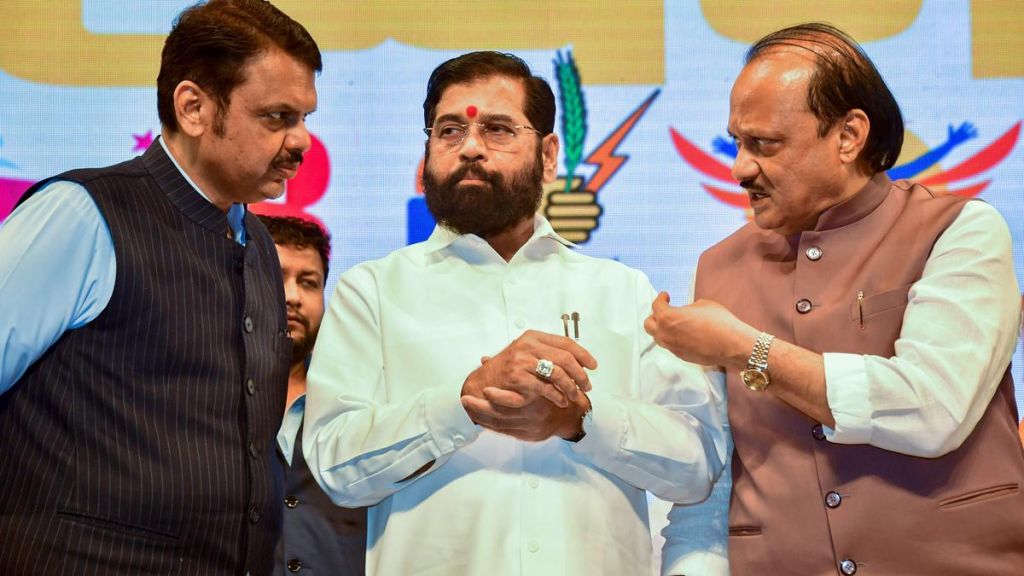
Mumbai: The 2024 Maharashtra Assembly elections have captured the nation’s attention, with exit polls projecting a potential victory for the ruling BJP-led Mahayuti alliance. If these predictions hold, the implications could ripple far beyond the state, reshaping political alliances and strategies.
Of the nine exit polls released after Wednesday's polling, six forecast a clear majority for the Mahayuti, while two favor the opposition Maha Vikas Aghadi (MVA). The remaining survey predicts a hung assembly, adding intrigue to an already charged political atmosphere.
Exit Polls
Surveys conducted by Poll Diary, Chanakya Strategies, Matriz, People Pulse, P-Marg, and CNX indicate that the Mahayuti will secure a comfortable majority, with seat projections ranging from 122 10 195. In contrast, SAS Group and Electoral Age give the edge to the MVA, projecting between 147 and 155 seats. Lok Shahi Marathi-Rudra stands apart, suggesting a hung assembly with both alliances within striking distance of forming the government. Poll Diary predicts the Mahayuti winning between 122 and 180 seats, with BJP emerging as the single largest party with 77-108 seats.
Chief Minister Eknath Shinde’s Shiv Sena faction is expected to secure 27-50 seats, while Deputy Chief Minister Ajit Pawar’s NCP faction might claim 18-28. On the other hand, the MVA could win 69-121 seats, with Congress (28-47), Shiv Sena (UBT) (16-35), and Sharad Pawar's NCP (25-39) splitting the tally. Chanakya Strategies suggests the BJP crossing 90 seats, while Shinde’s Sena and Pawar’s NCP faction may win 48 and 22 seats, respectively. The MVA's Congress faction could secure 63 seats, Thack- erays Sena 35, and Pawar's NCP around 40.
The CNX survey provides one of the highest estimates for Mahayuti, predicting 160–179 seats against the MVA’s 110–119. Conversely, the SAS Group and Electoral Age buck the trend, forecasting an MVA majority, with Congress as the dominant party in its fold. The Maharashtra elections have been characterized by shifting political allegiances and a highly polarized campaign.
Impact Of Splits
Splits in both the Shiv Sena and the NCP have significantly influenced the electoral landscape, with the BJP deftly maneuvering to capitalize on these divisions. Ajit Pawar’s defection from Sharad Pawar’s NCP has bolstered the Mahayuti’s urban and semi-urban appeal, while Eknath Shinde’s leadership has sought to consolidate rural and middle-class votes. The BJP’s campaign has centered on economic stability and infrastructure development, positioning itself as a harbinger of continuity and growth. On the other hand, the MVA, comprising the Congress, Shiv Sena (UBT), and Sharad Pawar's NCP faction, has tried to portray itself as a viable alternative, focusing on farmer distress, unemployment, and regional disparities. However, internal fractures and an inability to present a united front have undermined its appeal in crucial swing regions.
The 58.43% voter turnout, slightly lower than previous polls, indicates heightened interest in rural constituencies, traditionally seen as swing zones. The areas often determine the final outcome, and Mahayuti’s robust rural outreach could prove decisive. Exit polls suggest urban areas, particularly Mumbai and Pune, have leaned towards the BJP-led alliance, reflecting its resonance with middle-class and youth voters. However, the MVA has found support in agrarian districts, where anti-incumbency and dissatisfaction with government schemes are palpable. A decisive victory for the Mahayuti would bolster the BJP's momentum ahead of the general elections, reaffirming its dominance in India's political heartland.
A Key Battleground
Maharashtra, with its 48 parliamentary seats, is a key battleground for any national coalition, and a BJP-led sweep in the assembly could significantly influence Lok Sabha dynamics. Moreover, a Mahayuti win could further marginalize opposition parties like Congress and the NCP, which are already struggling to remain cohesive. It would also validate the BJP’s strategy of co-opting regional leaders like Ajit Pawar and Shinde, signaling a shift in how regional coalitions are formed and sustained. For the MVA, a strong performance could reinvigorate its standing as a formidable opposition bloc. It would demonstrate that voter dissatisfaction with the BJP's policies can translate into tangible electoral gains, energizing anti-BJP forces across India.
All Eyes On The Final Tally
As counting day approaches on November 23, all eyes will be on the final tally. If the Mahayuti secures a decisive majority, it will not only cement the BJP's position in Maharashtra but also reshape the national political landscape. Conversely, a surprise victory for the MVA or a hung assembly could pave the way for post-poll alliances, injecting further uncertainty into the political narrative. Ultimately, the Maharashtra elections have underscored the dynamic interplay of local and national politics, offering a preview of the strategies and alliances that will define India’s electoral future.